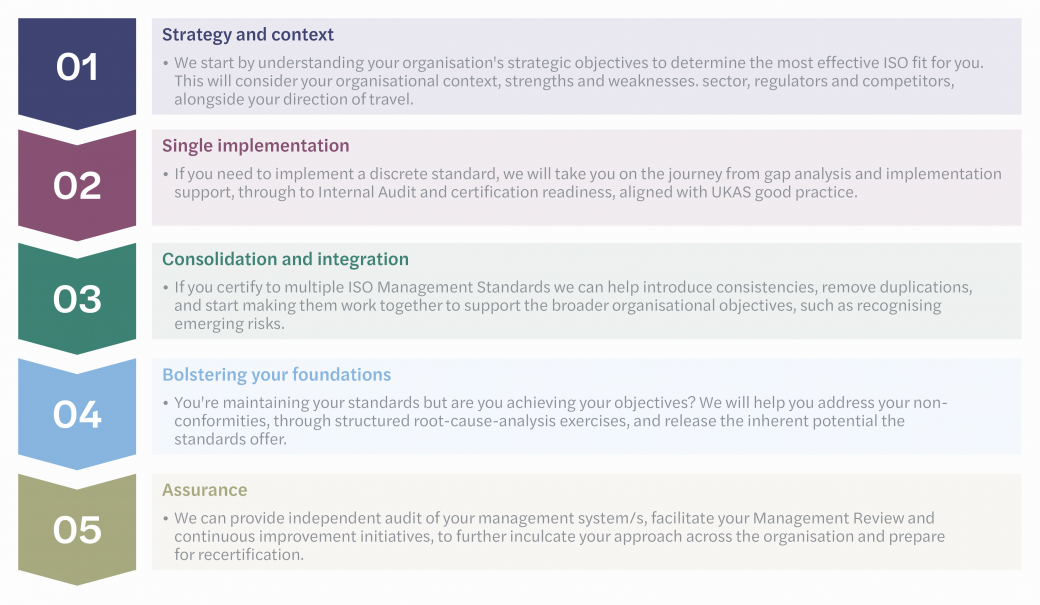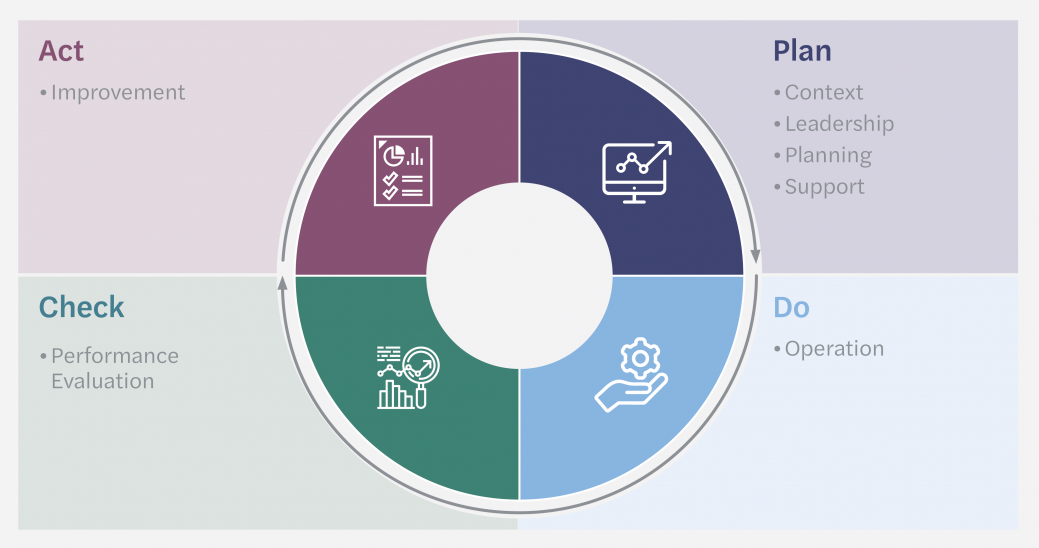ISO 9001:2015 Quality Management
ISO 9001:2015 is the foundation for an effective quality management system (QMS) to help improve processes, find cost efficiencies and ultimately, benefit customers and employees.
The certification underlines an organisation's commitment to its customers through the delivery of high-quality services and products. Using ISO 9001 helps ensure that customers get consistent, good quality products and services, which in turn brings many business benefits.
- Create a clear strategy and management system to oversee customer satisfaction
- Find efficiencies and cost savings by adopting an integrated approach
- Create a culture of continual improvement to improve engagement with employees
The ISO 9001 Quality Management standard has a number of industry drivers:
- It is required for many government and private sector tenders
- ISO standards are often cumulative. The specifications/ checklist for other ISO standards often builds upon ISO 9001
- ISO 9001 sets out the criteria for a quality management system and is the only standard in the family that can be certified (although this is not a requirement)
- It can be used by any organisation, large or small, regardless of its field of activity.
In fact, there are over one million companies and organisations in over 170 countries certified to ISO 9001.
Quality management principles
- Customer Focus
- Leadership
- Engagement of people
- Process approach
- Improvement
- Evidence-based decision making
- Relationship management
Will it help me increase my profits?
ISO 9001 can help bring financial benefits in a number of ways:
- Using ISO 9001 can increase productivity and efficiency, thus lowering the costs of an organisation
- Using ISO 9001 can improve customer experience, resulting in repeat business, increased sales and additional income for your business.
- Getting certified in ISO 9001 can enhance your reputation, attracting new customers to your organisation.
ISO 45001:2018 Occupational Health & Safety
Whether you are an employee, a manager or a business owner, you share a common goal – you are responsible for the safety of your workforce.
Improved productivity stems from ensuring people operate in workplaces that provide transparency and build trust throughout their operation and supply chain.
In addition, responsible practices are becoming increasingly important to brands and reputations. ISO 45001 is the ISO standard for Occupational Health and Safety (OH&S). It has become one of the most eagerly awaited standards in the world and is set to drastically improve levels of workplace safety. Given that ISO 45001 is becoming part of the business norm, regardless of whether organisations choose to adopt it or not, it’s important for companies to stay abreast of the latest developments.
What is on your mind?
- Continuous improvement of OH&S performance
- Fulfilment of legal requirements and other industry requirements
- Demonstrate your commitment to safety
- Prepare for the future
- Build trust with existing clients
- Engage your employees
- Reassure customers
- Win new business
How can ISO 45001 help you?
If your employees feel safe on the job, you will see improved productivity and trust throughout your organisation. Responsible practices are also more important to your brand and reputation than ever before. ISO 45001 helps reduce the risk of accidents, claims and costs — improving profits and keeping your workforce safe. Certification to the standard also:
- Demonstrates health and safety credentials
- Highlights a caring and compliant organisation
- Saves costs from public liability premiums
- Increases government contract opportunities.
Why now?
Having accreditation to this new standard provides our employees with a safe and healthy working environment, as well as helps to streamline processes and deliver efficiencies, saving time and money.
Further benefits of the standard include reduced absenteeism and staff turnover, leading to:
- Increased productivity
- Reduced cost of insurance premiums
- Creation of a health and safety culture, whereby employees are encouraged to take an active role in their own OH&S
- And enhanced reputation and improved staff morale.
ISO 14001:2015 Environmental Management
What is ISO 14001?
ISO 14001 sets out the criteria for an environmental management system and can be certified too.
It maps out a framework that a company or organisation can follow to set up an effective environmental management system. Designed for any type of organisation, regardless of its activity or sector, it can provide assurance to company management and employees as well as external stakeholders that environmental impact is being measured and improved.
Improve your reputation and gain a competitive advantage:
ISO 14001 certification is independently-assessed assurance that your organisation is operating in a responsible and sustainable manner. This can help reassure your customers that their patronage supports an organisation that is doing its part towards protecting the environment.
ISO 14001 enjoys an internationally-recognised reputation when it comes to environmental management, making it particularly credible when tendering for public sector or large company work. ISO 14001 gives you a marketing edge over your competitors, putting you head and shoulders above your rivals and proving that you take a more serious and sensible attitude to environmental issues. ISO 14001 could be the difference between winning and losing that vital contract.
How can ISO 14001 help you?
Reduce operation costs:
By reviewing your business, equipment and processes, working practices that are wasteful may be identified. Change can be targeted to the activity that generates the most benefit. Investments in new equipment, product redesign, process changes and staff training may all have a part to play in the elimination of waste materials, time, energy and effort.
Environmental improvement can lead to cost savings as well as environmental benefits. Savings in one area could be redeployed to invest in improved technology such as improved boilers, renewable energy schemes and insulation to make additional savings elsewhere.
Why now?
Achieve intended outcomes of an environmental management system, which provide value for the environment, the organisation itself and interested parties:
- Enhancement of environmental performance
- Fulfilment of compliance obligations
- Achievement of environmental objectives
- Improvement of brand reputation
- Engagement of staff
- Fulfilment of supplier requirements
- Gaining the ability to rapidly adapt to change
ISO 50001:2018 Energy Management
How can ISO 50001 help you?
ISO 50001 provides organisations with the opportunity to demonstrate their commitment to continual improvement in energy management, this typically dovetails with existing organisational ESG goals.
ISO 50001 provides very real benefits for organisations including: lower energy costs, optimised energy consumption and automatic compliance with the Energy Savings Opportunity Scheme (“ESOS”).
ISO 50001 can be the catalyst to embed an improvement culture across functions, regions and entities helping drive efficiencies and benefits on a wider scale.
ESOS Compliance
The Energy Savings Opportunity Scheme (ESOS) is a mandatory energy assessment scheme, introduced by the UK government to ensure enterprises in the UK are energy efficient. Under the scheme, organisations are required to assess their energy usage every four years.
The organisation must notify the Environment Agency by a set deadline that they have complied with their ESOS obligations. If you have:
- Over 250 members of staff, or a turnover of over 50 million Euros (£44.1m) or an annual balance sheet of over 43 million Euros (£37.9m)
- You are an overseas organisation with over 250 employees in the UK
- Your company is part of a larger organisation, which falls into any of the above
What is on your mind?
- Reputation management
- Conserving resources
- Improving the bottom line through efficient energy management
- Increasing energy awareness among staff members at all levels
- Addressing a business’ environmental impact
- Understanding and making data-driven decisions about energy use?
- Determining what types of energy consumed should be tracked?
Why now?
ISO 50001 is generally considered to be a good compliance route for ESOS which requires organisations to take responsibility for their own energy management and set targets for reduction.
The system provides good practice guidelines on gathering accurate energy usage data and developing a plan to improve operational efficiency. The standard is based on the Plan-Do-Check-Act continual improvement model which enables an organisation to continually evaluate the success of its energy consumption plan and keep improving it.
Whether your focus is on demonstrating compliance with ESOS or a broader strategic objective to contribute to the Sustainable Development Goals (SDGs), looking at ISO 50001 and other core ISO standards may be the best approach for you.
ISO 56002:2019 Innovation Management
Transformation and change are often an uphill battle but is also imperative to remain relevant and competitive
Companies and organisations are increasingly under pressure to innovate to retain their market share. This is especially true when it comes to radical or disruptive innovations such as electric vehicles, digitisation or accelerated product cycle and solutions due to changing consumer requirements which are challenging the current ways of working.
Organisations are struggling to innovate and many are dissatisfied with their innovation performance. Some have tried increasing the research and development budget and running creativity workshops without achieving the desired results. And this has come at great expense.
What does a structured approach to Innovation Management look like?
The Standard draws on the high-level structure (HLS) of the core ISO Management Standards to underpin its approach. Subsequently, it calls out a number of guiding principles:
- Opportunity identification
- Concept creation and validation
- Solutions development
- Solutions deployment
When enveloped in the continuous improvement framework this provides a robust structure for organisations to build out their discrete approaches to the management of innovation.
What is on your mind?
The International Organization for Standardization recently introduced the innovation management standard ISO 56002:2019 Innovation Management System which describes a cyclic Plan Do Check Act (PDCA) framework, which can help organisations develop a structured ability to:
- Manage innovative activities
- Respond to uncertainty
- Improve customer satisfaction
- Engage and empower people
- As well as enhance business reputation and value.
Why now?
The disruptive events of the last decade have challenged and focused organisations to think differently about how they deliver products and services.
“…organisations that give their managers and employees the tools to respond to and make the most of opportunities, both internal and external, are well placed to grow profits, improve the health and well-being of their employees and, thereby, the wider society.” (www.iso.org)
As organisations continue to navigate this volatile, uncertain, complex and ambiguous environment, enabling innovation will drive your organization forward.
ISO 22301:2019 Business Continuity
What is the Business Continuity Standard?
The scale and impact of a crisis or major disruption may be predicated by the preparation you have undergone prior to any given event. By investing time and resources in a comprehensive resilience and continuity programme you not only reduce your risk exposure and enhance the trust your stakeholders have, but you will also benefit from more effective operations which add competitive advantage during business as usual.
ISO 22301: 2019 establishes a fit for purpose strategic and operational framework that proactively improves an organisation's resilience against the disruption of its ability to achieve key objectives. It provides a rehearsed method of restoring an organisation's ability to supply its key products and services to an agreed level within an agreed time after a disruption and delivers a proven capability to manage a business disruption and protect the organisation's reputation and brand.
Why now?
To remain sustainable, and competitive and drive value for your shareholders in these challenging times, organisations must recognise things will not always go smoothly and plan for disruptions.
The last few years have reinforced this position with a multitude of a black swan or high impact low probability events such as the pandemic, Brexit, US Immigration policy, fuel and supply chain disruptions etc.
The acceleration of digital enablement and the demise of the high street has also forced businesses to “adapt or die” with a number of household names disappearing from our city centres.
Mapping the seven clauses against the PDCA model
The ISO 22301:2019 Business Continuity Management Standard follows the high-level structure of the ISO standards, with seven mandatory clauses aligned to the PDCA model.
What does this mean?
This has created an impetus for change through:
- Sector-specific business continuity or operational resilience requirements
- Reflecting on organisational or functional ‘health’ and considering transformative initiatives to leverage strengths and address weaknesses
- Certification to internationally recognised standards to:
- Meet market entry requirements.
- Inculcate best practices.
- Manage reporting obligations.
Get in touch
If you would like to understand how our teams can support your business, please do not hesitate to get in touch.
This website uses cookies.
Some of these cookies are necessary, while others help us analyse our traffic, serve advertising and deliver customised experiences for you.
For more information on the cookies we use, please refer to our Privacy Policy.
-
This website cannot function properly without these cookies.
-
Analytical cookies help us enhance our website by collecting information on its usage.
-
We use marketing cookies to increase the relevancy of our advertising campaigns.





